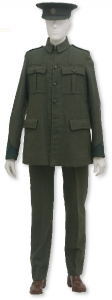The Irish Volunteer uniform
Published in Artefacts, Issue 6 (November/December 2013), Volume 21 Over 3,000 volunteers enrolled at the Rotunda Rink on 25 November 1913, and by June 1914 the Irish Volunteers had 180,000 members. In the space of seven months a massive volunteer army was created, but without the necessary access to the paraphernalia of a professional army—uniforms and weapons. It was up to the individual volunteer to purchase these, although it was not compulsory for them to do so. It was, however, deemed necessary for the officers, and they would have used one of the many military tailors in Ireland who provided officers’ uniforms for the British Army.
Over 3,000 volunteers enrolled at the Rotunda Rink on 25 November 1913, and by June 1914 the Irish Volunteers had 180,000 members. In the space of seven months a massive volunteer army was created, but without the necessary access to the paraphernalia of a professional army—uniforms and weapons. It was up to the individual volunteer to purchase these, although it was not compulsory for them to do so. It was, however, deemed necessary for the officers, and they would have used one of the many military tailors in Ireland who provided officers’ uniforms for the British Army.

Volunteer Seán O’Duffy’s uniform, for which he paid a tailor 25 shillings, quite a large sum of money then. Many Volunteers wore their uniforms during the 1916 Rising but were treated as traitors by the British rather than as prisoners of war.
With the rush to set up the Volunteers in late 1913, it was not until 12 August 1914 that a design for a uniform was agreed. The subcommittee established to create it wanted the uniform to be Irish-made and had problems sourcing the cloth—and later a clothing company—to make them. The chosen uniform was to consist of a grey-green tunic, trousers and puttees. As for headdress, the committee suggested a Cossack-style one. The first contract for the production of 300 uniforms went to the Limerick Clothing Company in Dublin, while the cloth was provided by Messers Morrogh Brothers of Douglas Mills, Cork.
In October 1914 Prof. Eoin MacNeill, chairman of the national executive of the Irish Volunteers, designed the cap badge for Volunteers’ cloth hats. The letters ‘FF’ represented Fianna Fáil, the legendary first standing army of Ireland, with ‘Óglaigh na h-Eireann’, meaning ‘soldiers of Ireland’, inscribed in a sword belt around it. There has been debate ever since about the symbolism of the sunburst and eight-pointed star behind ‘FF’ but there is no particular meaning. Most Volunteers who could not afford a uniform simply wore their normal civilian clothes and a brown belt with ‘Irish Volunteers’ inscribed on the buckle. Many of these buckles were home-made, so they vary widely. Since 1922 the Irish Army has used the design for the Irish Volunteer cap badge and buttons on their uniforms.

O’Duffy’s Volunteer cap badge and button, designs used by the Irish Army since 1922. The letters ‘FF’ represented Fianna Fáil, the legendary first standing army of Ireland.
(All images: National Museum of Ireland)
Lar Joye is curator of military history at the National Museum of Ireland (Decorative Arts).
Further reading
J. Hogan, Badges: medals: insignia—Óglaigh na hÉireann (Irish Defence Forces) (Dublin, 1987).
















